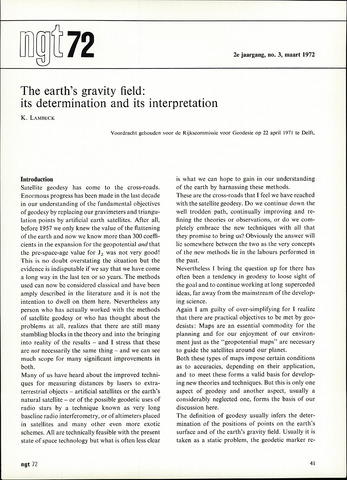The earth's gravity field:
its determination and its interpretation
2e jaargang, no. 3, maart 1972
K. Lambeck
Introduction
Satellite geodesy has come to the cross-roads.
Enormous progress has been made in the last decade
in our understanding of the fundamental objectives
of geodesy by replacing our gravimeters and triangu-
lation points by artificial earth satellites. After all,
before 1957 we only knew the value of the flattening
of the earth and now we know more than 300 coeffi
cients in the expansion for the geopotential and that
the pre-space-age value for J2 was not very good!
This is no doubt overstating the situation but the
evidence is indisputable if we say that we have come
a long way in the last ten or so years. The methods
used can now be considered classical and have been
amply described in the literature and it is not the
intention to dwell on them here. Nevertheless any
person who has actually worked with the methods
of satellite geodesy or who has thought about the
problems at all, realizes that there are still many
stumbling blocks in the theory and into the bringing
into reality of the results - and I stress that these
are not necessarily the same thing - and we can see
much scope for many significant improvements in
both.
Many of us have heard about the improved techni
ques for measuring distances by lasers to extra
terrestrial objects - artificial satellites or the earth's
natural satellite - or of the possible geodetic uses of
radio stars by a technique known as very long
baseline radio interferometry, or of altimeters placed
in satellites and many other even more exotic
schemes. All are technically feasible with the present
state of space technology but what is often less clear
is what we can hope to gain in our understanding
of the earth by harnassing these methods.
These are the cross-roads that I feel we have reached
with the satellite geodesy. Do we continue down the
well trodden path, continually improving and re
fining the theories or observations, or do we com
pletely embrace the new techniques with all that
they promise to bring us? Obviously the answer will
lie somewhere between the two as the very concepts
of the new methods lie in the labours performed in
the past.
Nevertheless I bring the question up for there has
often been a tendency in geodesy to loose sight of
the goal and to continue working at long superceded
ideas, far away from the mainstream of the develop
ing science.
Again I am guilty of over-simplifying for I realize
that there are practical objectives to be met by geo-
desists: Maps are an essential commodity for the
planning and for our enjoyment of our environ
ment just as the "geopotential maps" are necessary
to guide the satellites around our planet.
Both these types of maps impose certain conditions
as to accuracies, depending on their application,
and to meet these forms a valid basis for develop
ing new theories and techniques. But this is only one
aspect of geodesy and another aspect, usually a
considerably neglected one, forms the basis of our
discussion here.
The definition of geodesy usually infers the deter
mination of the positions of points on the earth's
surface and of the earth's gravity field. Usually it is
taken as a static problem, the geodetic marker re-
41
72
Voordracht gehouden voor de Rijkscommissie voor Geodesie op 22 april 1971 te Delft.
ngt 72

